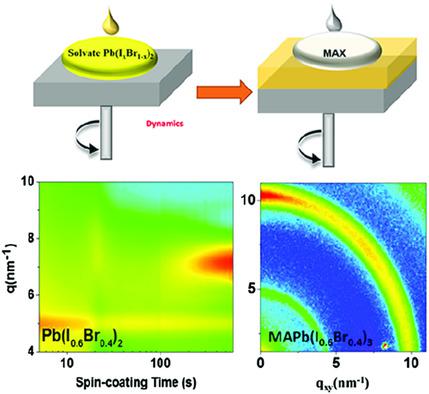Our official English website, www.x-mol.net, welcomes your
feedback! (Note: you will need to create a separate account there.)
Sequential Formation of Tunable‐Bandgap Mixed‐Halide Lead‐Based Perovskites: In Situ Investigation and Photovoltaic Devices
Solar RRL ( IF 6.0 ) Pub Date : 2020-11-04 , DOI: 10.1002/solr.202000668 Dounya Barrit 1, 2 , Yalan Zhang 3 , Tinghuan Yang 3 , Ming-Chun Tang 1 , Ruipeng Li 4 , Detlef-M. Smilgies 5 , Shengzhong (Frank) Liu 3 , Thomas D. Anthopoulos 1 , Aram Amassian 6 , Kui Zhao 3
Solar RRL ( IF 6.0 ) Pub Date : 2020-11-04 , DOI: 10.1002/solr.202000668 Dounya Barrit 1, 2 , Yalan Zhang 3 , Tinghuan Yang 3 , Ming-Chun Tang 1 , Ruipeng Li 4 , Detlef-M. Smilgies 5 , Shengzhong (Frank) Liu 3 , Thomas D. Anthopoulos 1 , Aram Amassian 6 , Kui Zhao 3
Affiliation

|
Inorganic−organic hybrid perovskites MAPb(IxBr1−x)3 (0 < x < 1) hold promise for efficient multi‐junction or tandem solar cells due to tunable bandgap and improved long‐term stability. However, the phase transformation from Pb(IxBr1−x)2 precursors to perovskites is not fully understood which hinders further improvement of optoelectronic properties and device performance. Here, adaptation of the two‐step deposition method, which enables the direct probe into the growth dynamics of perovskites using in situ diagnostics, and a detailed view of the effects of solvent, lead halide film solvation, and Br incorporation and alloying on the transformation behavior is presented. The in situ measurements indicate a strong tendency of lead halide solvation prior to crystallization during solution‐casting Pb(IxBr1−x)2 precursor from a dimethyl sulfoxide (DMSO) solvent. Highly‐efficient intramolecular exchange is observed between DMSO molecules and organic cations, leading to room‐temperature conversion of perovskite and high‐quality films with tunable bandgap and superior optoelectronic properties in contrast to that obtained from crystalline Pb(IxBr1−x)2. The improved properties translate to easily tunable and a relatively higher power conversion efficiency of 16.42% based on the mixed‐halide perovskite MAPb(I0.9Br0.1)3. These findings highlight the benefits that solvation of the precursor phases, together with bromide incorporation, can have on the microstructure, morphology, and optoelectronic properties of these films.
中文翻译:

可调谐带隙混合卤化物铅基钙钛矿的依次形成:原位研究和光伏装置
无机-有机杂化钙钛矿MAPb(I x Br 1- x)3(0 < x <1)由于可调节的带隙和改善的长期稳定性而有望实现高效的多结或串联太阳能电池。然而,从Pb(I x Br 1- x)2的相变钙钛矿的前体尚未被完全理解,这阻碍了光电性能和器件性能的进一步提高。在这里,采用了两步沉积方法,可以使用原位诊断程序直接探查钙钛矿的生长动力学,并详细介绍了溶剂,卤化铅薄膜溶剂化以及Br掺入和合金化对转变的影响行为被提出。原位测量表明在溶液浇铸Pb(I x Br 1- x)2之前,结晶前卤化铅有很强的溶剂化趋势来自二甲亚砜(DMSO)溶剂的前驱体。观察到DMSO分子与有机阳离子之间的高效分子内交换,从而导致钙钛矿和具有可调带隙且具有优异光电性能的高品质膜的室温转化,这与从晶体Pb(I x Br 1- x)获得的相反2。基于混合卤化物钙钛矿MAPb(I 0.9 Br 0.1)3,改进后的性能可转换为易于调谐且相对较高的功率转换效率,为16.42%。这些发现凸显了前体相的溶剂化以及溴化物的掺入对这些薄膜的微观结构,形态和光电性能的好处。
更新日期:2021-01-07
中文翻译:

可调谐带隙混合卤化物铅基钙钛矿的依次形成:原位研究和光伏装置
无机-有机杂化钙钛矿MAPb(I x Br 1- x)3(0 < x <1)由于可调节的带隙和改善的长期稳定性而有望实现高效的多结或串联太阳能电池。然而,从Pb(I x Br 1- x)2的相变钙钛矿的前体尚未被完全理解,这阻碍了光电性能和器件性能的进一步提高。在这里,采用了两步沉积方法,可以使用原位诊断程序直接探查钙钛矿的生长动力学,并详细介绍了溶剂,卤化铅薄膜溶剂化以及Br掺入和合金化对转变的影响行为被提出。原位测量表明在溶液浇铸Pb(I x Br 1- x)2之前,结晶前卤化铅有很强的溶剂化趋势来自二甲亚砜(DMSO)溶剂的前驱体。观察到DMSO分子与有机阳离子之间的高效分子内交换,从而导致钙钛矿和具有可调带隙且具有优异光电性能的高品质膜的室温转化,这与从晶体Pb(I x Br 1- x)获得的相反2。基于混合卤化物钙钛矿MAPb(I 0.9 Br 0.1)3,改进后的性能可转换为易于调谐且相对较高的功率转换效率,为16.42%。这些发现凸显了前体相的溶剂化以及溴化物的掺入对这些薄膜的微观结构,形态和光电性能的好处。











































 京公网安备 11010802027423号
京公网安备 11010802027423号